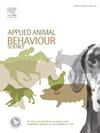Do pairs exhibit similar behaviours? Evaluating inter-individual synchrony in activities of Magellanic penguins
IF 2.2
2区 农林科学
Q1 AGRICULTURE, DAIRY & ANIMAL SCIENCE
引用次数: 0
Abstract
Animal welfare is a key priority in modern zoos and aquariums, with behavioural observations widely adapted as practical and effective methods for its assessment. Although increasing attention has been given to inter-individual interactions within a group, which can enhance animal welfare, such studies remain limited due to logistical constraints associated with conducting continuous behavioural observations alongside individual identification. Penguins, in particular, present significant challenges, as they are typically housed in groups and spend part of their time in aquatic environment. In this study, we employed animal-borne data loggers to record the on-water and on-land activities of captive Magellanic penguins Spheniscus magellanicus. The aim was to examine the behavioural synchrony of paired individuals, presumed to share close bonds, and consequently to explore which behavioural parameter could serve as a proxy for inter-individual affinity. On-water and on-land activities were monitored using immersion sensors attached to the flipper bands of 23 penguins, including three bonded pairs, at Sumida Aquarium, Tokyo, Japan, from 11 October 2022–9 October 2023. To assess inter-individual synchrony, kappa coefficient values were calculated for all unique pairwise combinations. Synchrony within pairs was relatively low during the breeding period but increased significantly during the non-breeding period, with on-water activity showing a marked tendency to be distinctly higher within pairs compared to non-paired individuals, serving as a proxy for inter-individual affinity in penguins. Additionally, simulated pseudo-observations suggested that approximately 250 intermittent observations of on-water instances are required to reliably detect substantial behavioural synchrony among individuals, which offers an alternative methodology that is both practical and suitable for daily observation settings by keepers. This study revealed significant synchrony in on-water activity during the non-breeding period within pairs; however, no data were available regarding inter-individual distances or other relevant interactions. Therefore, further research is needed to investigate spatial proximity and social interactions in greater detail to gain deeper insights.
成对是否表现出相似的行为?麦哲伦企鹅活动的个体间同步性评价
动物福利是现代动物园和水族馆的首要任务,行为观察被广泛采用为评估动物福利的实用而有效的方法。尽管人们越来越关注群体内个体间的相互作用,这可以提高动物福利,但由于在进行个体识别的同时进行连续的行为观察所受到的后勤限制,此类研究仍然有限。尤其是企鹅,它们面临着巨大的挑战,因为它们通常是群居的,而且大部分时间都在水生环境中度过。在本研究中,我们使用动物携带的数据记录仪记录了圈养麦哲伦企鹅Spheniscus magellanicus在水和陆地上的活动。其目的是检查被认为拥有亲密关系的成对个体的行为同步性,从而探索哪些行为参数可以作为个体间亲和关系的代理。从2022年10月11日至9日 2023年10月9日,在日本东京的Sumida水族馆,用连接在23只企鹅鳍带上的浸入式传感器监测了水上和陆地上的活动,其中包括3对结合在一起的企鹅。为了评估个体间的同步性,计算了所有独特的两两组合的kappa系数值。企鹅在繁殖期的同步性相对较低,而在非繁殖期的同步性显著增加,在水中的同步性表现出明显高于非配对个体的趋势,这可以作为企鹅个体间亲和关系的代表。此外,模拟的伪观察表明,要可靠地检测个体之间的大量行为同步性,需要对水中实例进行大约250次间歇观察,这为饲养员提供了一种既实用又适合日常观察设置的替代方法。本研究发现,在非繁殖期,成对间的水上活动具有显著的同步性;然而,没有关于个体间距离或其他相关相互作用的数据。因此,需要进一步的研究来更详细地调查空间接近性和社会互动,以获得更深入的见解。
本文章由计算机程序翻译,如有差异,请以英文原文为准。
求助全文
约1分钟内获得全文
求助全文
来源期刊

Applied Animal Behaviour Science
农林科学-行为科学
CiteScore
4.40
自引率
21.70%
发文量
191
审稿时长
18.1 weeks
期刊介绍:
This journal publishes relevant information on the behaviour of domesticated and utilized animals.
Topics covered include:
-Behaviour of farm, zoo and laboratory animals in relation to animal management and welfare
-Behaviour of companion animals in relation to behavioural problems, for example, in relation to the training of dogs for different purposes, in relation to behavioural problems
-Studies of the behaviour of wild animals when these studies are relevant from an applied perspective, for example in relation to wildlife management, pest management or nature conservation
-Methodological studies within relevant fields
The principal subjects are farm, companion and laboratory animals, including, of course, poultry. The journal also deals with the following animal subjects:
-Those involved in any farming system, e.g. deer, rabbits and fur-bearing animals
-Those in ANY form of confinement, e.g. zoos, safari parks and other forms of display
-Feral animals, and any animal species which impinge on farming operations, e.g. as causes of loss or damage
-Species used for hunting, recreation etc. may also be considered as acceptable subjects in some instances
-Laboratory animals, if the material relates to their behavioural requirements
 求助内容:
求助内容: 应助结果提醒方式:
应助结果提醒方式:


